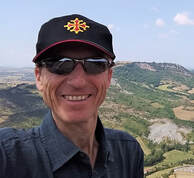 Occitanie has played a central role in our understanding of prehistory, and Ariège boasts more prehistoric caves than any other department in France. Over a period of several months last year, I visited several of the ones that are open to the public. The prehistorians who were involved in the discovery or interpretation of these grottes were in many cases the same internationally renowned experts who explored even more famous caves which lie just outside my region (Lascaux, Les Eyzies and the Grotte de Chauvet, for example). They included people like Émile Cartailhac who, in 1882, took up a post at the faculty of science in Toulouse and became the first academic in France to teach prehistoric archaeology. And a young priest called Henri Breuil who, over the next 60 years, would become even more influential than Cartailhac. And more recently, Jean Clottes, the man who was called upon to assess the Grotte de Chauvet when it was rediscovered in 1994. Grotte de Niaux The Grotte de Niaux on the outskirts of Tarascon-sur-Ariège is famous for its prehistoric paintings of bison, deer, ibex, horses and even a fish. The best-known and most-visited part of the complex is a spacious chamber called Le Salon Noir. It lies deep inside the mountain, 800 metres from the main entrance. At the time of my first visit ten years ago, I was struck by the quantity of graffiti left by more recent visitors. Most of them had been cleaned off by the time I made my second visit, but one specimen has been retained as a historical relic in its own right, a signature left in Le Salon Noir by Ruben de la Vialle in 1660. A veteran tourist guide from Niaux claims to have identified 16 other examples of Ruben de la Vialle’s signature in different parts of the cave. Why he came so often is a mystery. In the summer of 1660, he was waiting for his exam results, having studied for a doctorate in both civil and canonical law. Despite his education, Ruben had no way of knowing or even suspecting the age or significance of the paintings at Niaux. In fact, the religious side of his education made it inconceivable. A few years earlier, an Irish archbishop called James Ussher had, after long and careful study of the Old Testament, calculated with extraordinary precision that the world had been created on 23 October 4004 BCE. It would have been both heretical and illogical for Ruben to imagine that the paintings at Niaux were at least 10,000 years older than the world itself. Their importance only became recognised in 1906 when an infantry officer called Jules Molard and his two sons visited Le Salon Noir and decided to tell Émile Cartailhac about their ‘discovery’. Cartailhac and Breuil explored the cave in the autumn of the same year. Directly opposite Niaux on the left bank of the Vicdessos river lies a smaller prehistoric cave. If the Grotte de Niaux was something of an artist’s studio, the Grotte de la Vache was more of a residential property, and the paintings in the former may have been produced by the people who lived in the latter. The Grotte de la Vache is privately owned and it was closed when I was there in 2022 as it had been for several years before that. However, the area outside the cave entrance was fenced off and building works were in progress. Reports in the local press suggest that a reopening is planned, but the date has yet to be confirmed. FOLLOW THESE LINKS TO READ OTHER SECTIONS OF THIS POST:
Prehistoric caves of Occitanie 1: Grotte d’Aurignac Prehistoric caves of Occitanie 3: Grotte de Bédeilhac Prehistoric caves of Occitanie 4: Grotte de Gargas Prehistoric caves of Occitanie 5: Grotte de Mas d’Azil Prehistoric caves of Occitanie 6: Caune de l’Arago and the Tautavel museum of prehistory
0 Comments
Your comment will be posted after it is approved.
Leave a Reply. |
Colin Duncan Taylor"I have been living in the south of France for 20 years, and through my books and my blog, I endeavour to share my love for the history and gastronomy of Occitanie and the Pyrenees." |


 RSS Feed
RSS Feed
